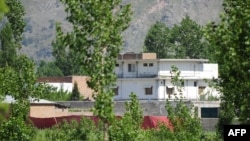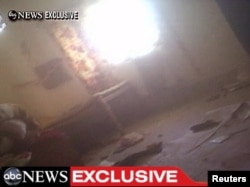ABBOTTABAD, Pakistan -- For 10 years, the world has expected that if Osama bin Laden were ever found, it would be in a cave somewhere in the mountains on either side of the Afghanistan-Pakistan border.
The expectations grew, in part, from U.S. President George W. Bush's famous promise four days after 9/11 to "smoke out" Al-Qaeda and its leaders.
They also grew with Bush's later comments that bin Laden encouraged suicide bombings while he and his top associate "save their own skins by hiding in caves."
But the news that bin Laden was found, not in a cave, but in one of Pakistan's most popular hill resort towns, set all expectations on their head. The Al-Qaeda chief may indeed have been caught hiding, but his hideout was a three-story, million-dollar mansion with all the amenities.
Abbottabad, Osama's place of refuge, is a verdant town located in the hills 60 kilometers north of Islamabad at an altitude of about 1,250 meters. The city is not well-known outside of Pakistan, but it is extremely well-known inside the country, where its pleasant weather makes it a hub for tourism.
'Peaceful Environment'
Fawad Ali Shah, a correspondent for RFE/RL's Radio Mashaal in Abbottabad, says the town's reputation is not for militancy. Instead, it has a high concentration of top schools and military establishments and is the home of many retired Pakistani military officers.
"It is the home of the Baluch Regiment of the Pakistan Army, of the Pakistani military academy Kakul, in which the newly commissioned armed forces officers are trained, and there also are many educational institutes," Shah says. "So, basically, it is a cantonment and people living here are peaceful and the environment is peaceful."
Bin Laden's mansion was just 90 meters from the gate of the Kakul Military Academy, the army-run institution where top officers train. His house itself resembled a fort, with two security gates and compound walls 3.5-to-5.5-meters high, topped with barbed wire.
A Pakistan intelligence official said the property where bin Laden was staying was 278 square meters in size and that the residents burned their own trash rather than letting the city collect it. No Internet or phone connection led to the house, so all messages arrived and left with couriers.
'No One Could Have Imagined'
One might expect the secretive nature of the house, which Washington says appears to have been "custom-built to hide someone of significance" in 2005, would arouse local suspicion. But Shah says it did not, perhaps because Abbottabad seemed like such an unlikely place to find the bearded cave-warrior depicted by Washington.
"No one could have imagined that a man of such high profile could have hidden here," Shah says. "Everyone is shocked that Osama bin Laden was hiding here in Abbottabad, because basically the elite of Pakistan lives here."
But if Abbottabad, which is far from Afghanistan's tribal regions where bin Laden was most frequently assumed to be hiding, is an idyllic spot, it does have some features that might help explain bin Laden's presence there.
The hilly region around Abbottabad was long home -- with the Pakistani military's consent -- to training camps for mujahedin groups operating in Kashmir. The mujahedin groups, which carried out guerrilla operations in the Indian-held area of Kashmir, made common cause with the Afghan Taliban and other jihadist groups in Pakistan's tribal areas after 9/11, when Pakistan officially became an ally of the United States in the war on terror.
The familiarity and contacts that the Pakistani mujahedin groups have with the Abbottabad region also could serve anyone hiding out in the area well, especially such a prominent figure in the jihad against the United States as Osama bin Laden.
'To Your Natural Beauty Do I Bow'
One ironic footnote to bin Laden's taking refuge in Abbottabad is the fact that the Saudi Arabian jihadist is just one of many foreigners who have been attracted to the town over its lifetime.
The town was founded by a British officer in 1853 after the annexation of Punjab. Major James Abbott named the town after himself and later immortalized it in a poem expressing the beauty of its surroundings.
The poem, written prior to Abbott's return to Britain eight years later, declares:
It is not known if the austere bin Laden was as moved by Abbottabad's beauty as many others have been. But the final gift of a few sad tears may be all he, too, leaves from a stay whose duration is not yet known.
written in Prague by Charles Recknagel, with contributions from RFE/RL's Radio Mashaal in Abbottabad

Features & Analysis
Washington Contemplates Next Move After Bin Laden's Death
Was Remote Pakistani Village A Bin Laden Hideout?
Bin Laden's Death Casts Pall Over U.S.-Pakistan Relations
Bin Laden's Death Casts Pall Over U.S.-Pakistan Relations
The President’s Triumph: Obama Gets His Man
Which Way For Pakistani Leadership?
Does Torture Work? Bin Laden's Killing Reopens Debate On 'Black Site' Interrogations
Bin Laden Conspiracy Theories Flourish
'Can We Get Our Ball Back, Mister?' -- Living Next Door To Osama Bin Laden
Osama Is Dead, But His War Continues
Hamid Mir, The Last Man To Interview Bin Laden
How The U.S. Found, And Killed, Bin Laden
Abbottabad, The Peaceful Pakistani City Where Bin Laden Met His Violent End
Bin Laden Killing Puts Pakistan On The Spot
Importance Of Bin Laden's Death May Lie In Its Symbolism
Blogs
Abbottabad Divided Over Whether To Destroy Osama Compound
'The Lion': Reactions To Bin Laden's Death Mixed In Afghanistan
Why The United States Should Be Cautious About Releasing Osama Bin Laden's Death Photos
Pakistan's Pashtuns React To Bin Laden's Death
Photo Galleries
Osama Bin Laden: A Terrorist's Life
Bin Laden's Death Welcomed With Spontaneous Celebrations
Podcast
Bin Laden's Death Casts Doubt On Pakistan, Torture
Videos
Disbelief In Abbottabad
Pakistani Lawyers Pray For Bin Laden
Osama Bin Laden: A History Of Violence
The expectations grew, in part, from U.S. President George W. Bush's famous promise four days after 9/11 to "smoke out" Al-Qaeda and its leaders.
They also grew with Bush's later comments that bin Laden encouraged suicide bombings while he and his top associate "save their own skins by hiding in caves."
For the latest on the bin Laden story, follow RFE/RL's Pakistani and Afghan journalists on Twitter at @GandharaRFE
Abbottabad, Osama's place of refuge, is a verdant town located in the hills 60 kilometers north of Islamabad at an altitude of about 1,250 meters. The city is not well-known outside of Pakistan, but it is extremely well-known inside the country, where its pleasant weather makes it a hub for tourism.
'Peaceful Environment'
Fawad Ali Shah, a correspondent for RFE/RL's Radio Mashaal in Abbottabad, says the town's reputation is not for militancy. Instead, it has a high concentration of top schools and military establishments and is the home of many retired Pakistani military officers.
"It is the home of the Baluch Regiment of the Pakistan Army, of the Pakistani military academy Kakul, in which the newly commissioned armed forces officers are trained, and there also are many educational institutes," Shah says. "So, basically, it is a cantonment and people living here are peaceful and the environment is peaceful."
A video grab shows a gaping hole in the wall of the mansion where Osama bin Laden was killed in a firefight with U.S. forces in Abbottabad.
Bin Laden's mansion was just 90 meters from the gate of the Kakul Military Academy, the army-run institution where top officers train. His house itself resembled a fort, with two security gates and compound walls 3.5-to-5.5-meters high, topped with barbed wire.
A Pakistan intelligence official said the property where bin Laden was staying was 278 square meters in size and that the residents burned their own trash rather than letting the city collect it. No Internet or phone connection led to the house, so all messages arrived and left with couriers.
'No One Could Have Imagined'
One might expect the secretive nature of the house, which Washington says appears to have been "custom-built to hide someone of significance" in 2005, would arouse local suspicion. But Shah says it did not, perhaps because Abbottabad seemed like such an unlikely place to find the bearded cave-warrior depicted by Washington.
"No one could have imagined that a man of such high profile could have hidden here," Shah says. "Everyone is shocked that Osama bin Laden was hiding here in Abbottabad, because basically the elite of Pakistan lives here."
But if Abbottabad, which is far from Afghanistan's tribal regions where bin Laden was most frequently assumed to be hiding, is an idyllic spot, it does have some features that might help explain bin Laden's presence there.
The hilly region around Abbottabad was long home -- with the Pakistani military's consent -- to training camps for mujahedin groups operating in Kashmir. The mujahedin groups, which carried out guerrilla operations in the Indian-held area of Kashmir, made common cause with the Afghan Taliban and other jihadist groups in Pakistan's tribal areas after 9/11, when Pakistan officially became an ally of the United States in the war on terror.
The familiarity and contacts that the Pakistani mujahedin groups have with the Abbottabad region also could serve anyone hiding out in the area well, especially such a prominent figure in the jihad against the United States as Osama bin Laden.
'To Your Natural Beauty Do I Bow'
One ironic footnote to bin Laden's taking refuge in Abbottabad is the fact that the Saudi Arabian jihadist is just one of many foreigners who have been attracted to the town over its lifetime.
The town was founded by a British officer in 1853 after the annexation of Punjab. Major James Abbott named the town after himself and later immortalized it in a poem expressing the beauty of its surroundings.
The poem, written prior to Abbott's return to Britain eight years later, declares:
Oh Abbottabad, we are leaving you now
To your natural beauty do I bow
Perhaps your winds' sound will never reach my ears
My gift for you is a few sad tears.
To your natural beauty do I bow
Perhaps your winds' sound will never reach my ears
My gift for you is a few sad tears.
It is not known if the austere bin Laden was as moved by Abbottabad's beauty as many others have been. But the final gift of a few sad tears may be all he, too, leaves from a stay whose duration is not yet known.
written in Prague by Charles Recknagel, with contributions from RFE/RL's Radio Mashaal in Abbottabad
The Death Of Osama Bin Laden
The Death Of Osama Bin Laden

Features & Analysis
Washington Contemplates Next Move After Bin Laden's Death
Was Remote Pakistani Village A Bin Laden Hideout?
Bin Laden's Death Casts Pall Over U.S.-Pakistan Relations
Bin Laden's Death Casts Pall Over U.S.-Pakistan Relations
The President’s Triumph: Obama Gets His Man
Which Way For Pakistani Leadership?
Does Torture Work? Bin Laden's Killing Reopens Debate On 'Black Site' Interrogations
Bin Laden Conspiracy Theories Flourish
'Can We Get Our Ball Back, Mister?' -- Living Next Door To Osama Bin Laden
Osama Is Dead, But His War Continues
Hamid Mir, The Last Man To Interview Bin Laden
How The U.S. Found, And Killed, Bin Laden
Abbottabad, The Peaceful Pakistani City Where Bin Laden Met His Violent End
Bin Laden Killing Puts Pakistan On The Spot
Importance Of Bin Laden's Death May Lie In Its Symbolism
Blogs
Abbottabad Divided Over Whether To Destroy Osama Compound
'The Lion': Reactions To Bin Laden's Death Mixed In Afghanistan
Why The United States Should Be Cautious About Releasing Osama Bin Laden's Death Photos
Pakistan's Pashtuns React To Bin Laden's Death
Photo Galleries
Osama Bin Laden: A Terrorist's Life
Bin Laden's Death Welcomed With Spontaneous Celebrations
Podcast
Bin Laden's Death Casts Doubt On Pakistan, Torture
Videos
Disbelief In Abbottabad
Pakistani Lawyers Pray For Bin Laden
Osama Bin Laden: A History Of Violence


















